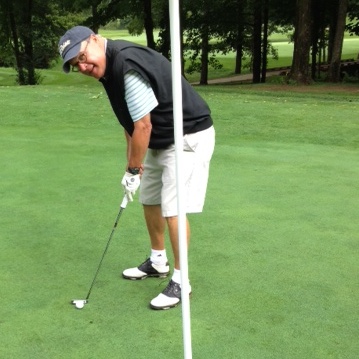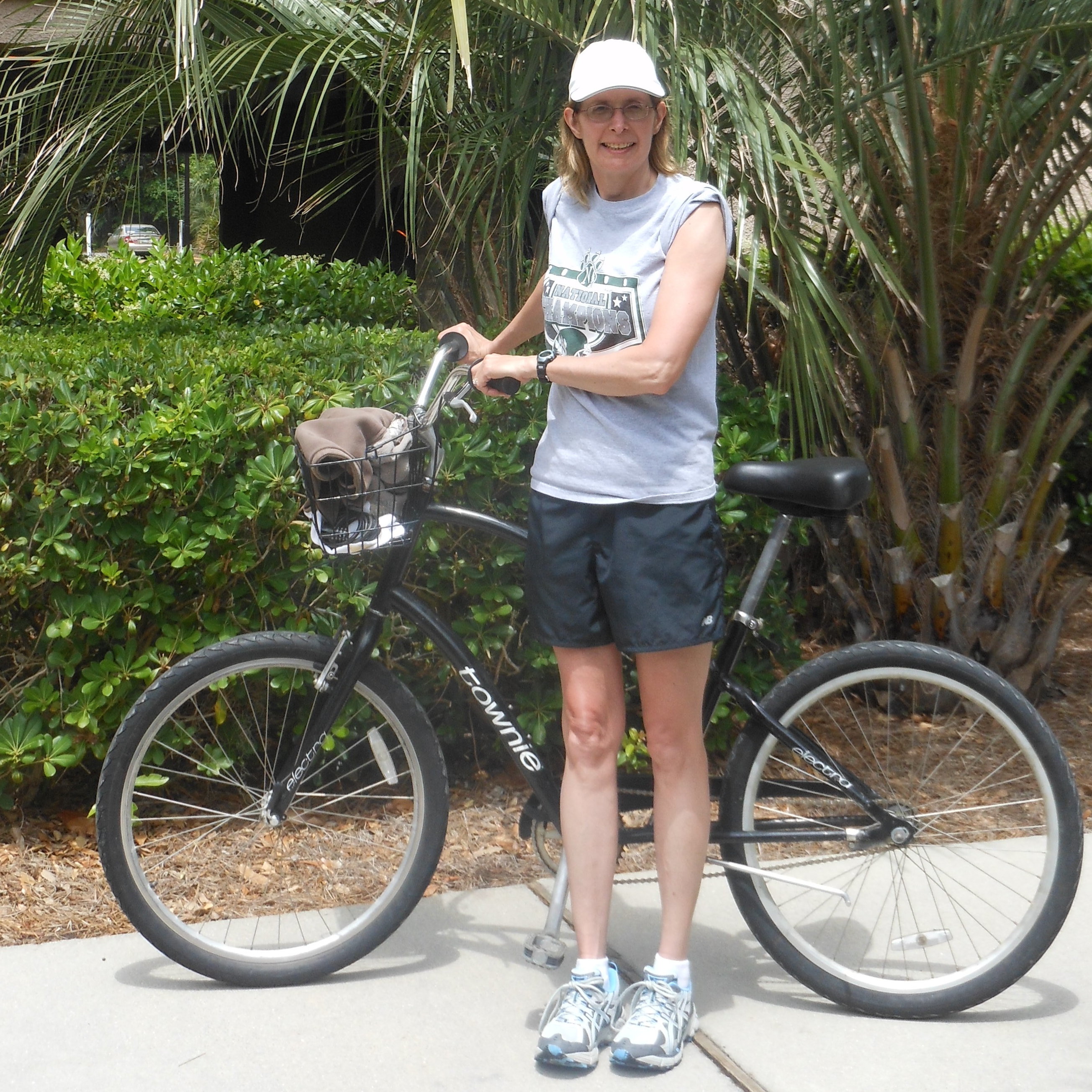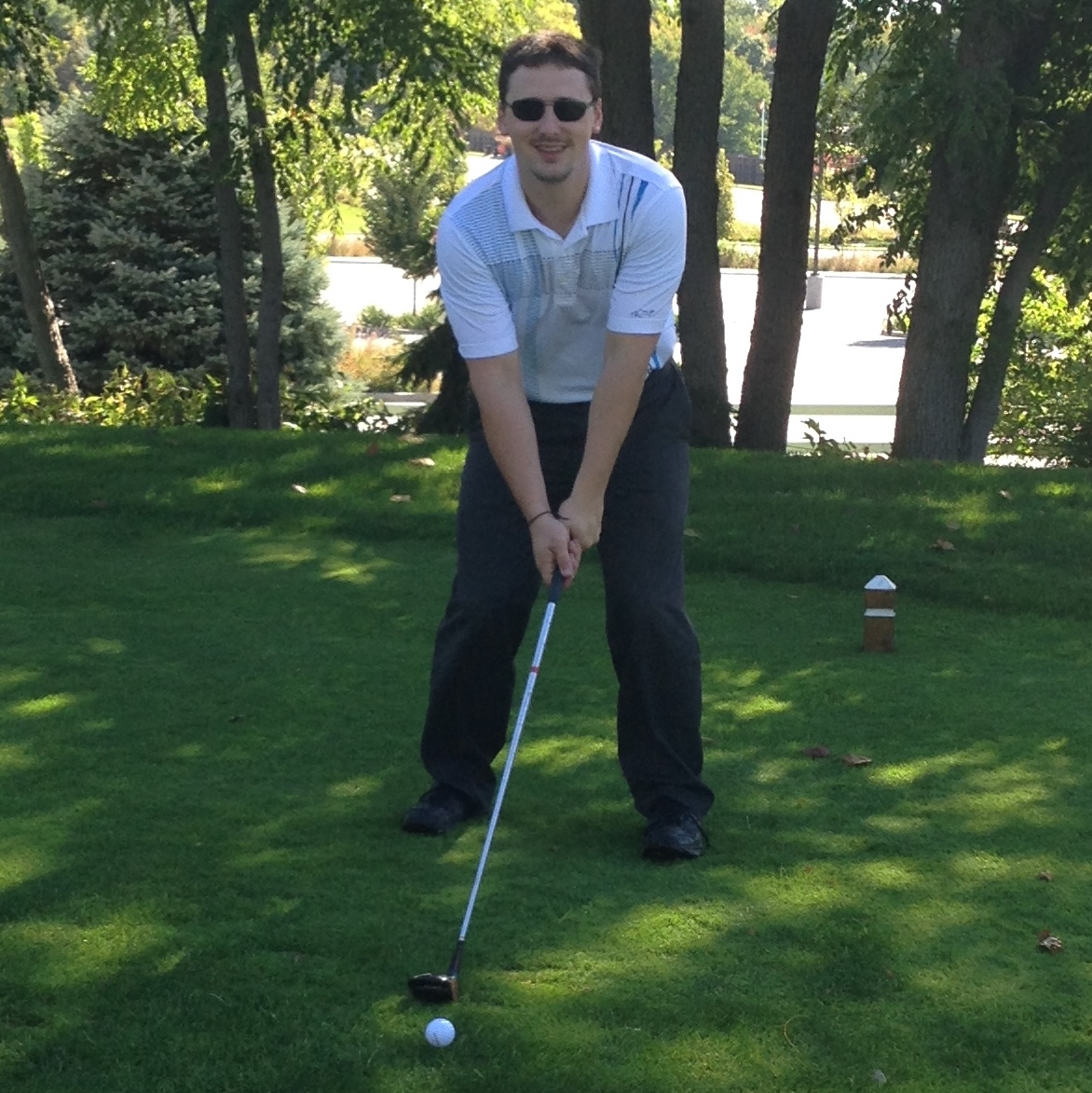End of a Golden Era: The Demise of a PETE ProgramThomas J. Templin, Bonnie Blankenship, K. Andrew R. Richards (Purdue University)
We are sad and a bit angry – maybe even confused.
Due to significant falling enrollments it was decided by departmental and college administrators that we will admit the last class of PETE students in the
fall of 2014, and class-by-class the program will disappear in four years. While the legacy of the program will carry on through those who have graduated
over the years, our students will no longer walk the halls of our building or reside in our classrooms, gymnasium, swimming pool, or local schools. Our
faculty will no longer engage in teaching PETE students or supervising field experiences. Those who retain their positions will contribute to the movement
and sport science curriculum, if they are lucky. Some may decide to pursue positions elsewhere. Some may be dismissed.
Purdue is not the first large research-intensive university to announce the discontinuation of its PETE program of late. The University of Michigan (the
first author’s alma mater) has also decided to close its PETE program doors. This troubling trend led a colleague from another institution to point out
that “this appears to be another sign of the end of the golden era in PETE.” Yes, this is true for Purdue’s contribution to the State of Indiana in
preparing future physical education professionals. The other twenty-one institutions in the state that prepare physical educators will carry on – at least
for the time being.
You may be asking yourself “why did this happen and did we see it coming?” And you may be wondering if we tried to prevent the closing of the program, or
if there is anything you can do to safeguard your program. The remainder of this essay will address these questions and related issues.
The Context and the Story
At the zenith of Purdue’s PETE program, it was not uncommon to have over 200 students enrolled each academic year. It was a robust teaching major from its
conception up until the last five years. With five tenure-track faculty along with a few clinical staff and graduate teaching assistants, our PETE students
receive a great education and are well prepared to go out into the “real world” of public school teaching. Purdue has had a reputation for preparing
excellent physical education teachers, and it still does. Our faculty has been and will continue to be one of the best around.
Our undergraduate placement rate has been above 90% and we have witnessed excellent programming and teaching by our graduates. They have made us proud.
Equally, many in-service teachers have turned to our program for professional development as evidenced by the awarding of a Carol M. White Physical
Education for Progress grant in 2008. Furthermore, a cadre of doctoral students have studied with our faculty and have gone on to impact teacher education
programs and sport pedagogy research throughout the U.S. and world.
Our undergraduate program mirrored most programs in the U.S. Beyond university general education requirements, our students met course requirements through
the Kinesiology core, College of Health and Human Science and College of Liberal Arts core, College of Education requirements, and PETE program
requirements (See Table 1).
Table 1.
Overview of the key requirements of the Purdue University PETE program
|
Health and Physical Education Content Courses
|
Credit Hours
|
|
HK 10300 Creative Rhythms & Dance
|
1
|
|
HK 10400 Educational Gymnastics & Adventure Education
|
2
|
|
HK 10500 Development & Analysis of Invasion Games
|
2
|
|
HK 10600 Development & Analysis of Net/Wall Games
|
2
|
|
HK 10700 Development & Analysis of Target & Field Games
|
2
|
|
HK 11200 Aquatics
|
1
|
|
HK 11400 Teaching Fitness in Physical Education
|
2
|
|
HK 20800 Prevention & Treatment of Athletic Injuries
|
3
|
|
HK 21000 History & Philosophy of Physical Education
|
2
|
|
HK 21900 Personal & Community Health
|
2
|
|
HK 22500 Sexuality & Health
|
3
|
|
HK 23100 Substance Abuse & Health
|
3
|
|
HK 23300 Stress & Human Health
|
3
|
|
HK 23500 Teacher Education Sophomore Seminar
|
1
|
|
HK 26400 Principles of Motor Learning, Development, & Biomechanics
|
3
|
|
HK 32600 Foundations of Adapted Physical Education
|
3
|
|
HK 32900 Curriculum in Physical Education
|
3
|
|
HK 33500 Teacher Education Junior Seminar
|
1
|
|
HK 36500 Principles of Community Health Promotion
|
3
|
|
HK 36600 Health Behavior & Health Promotion
|
3
|
|
HK 36800 Exercise Physiology I
|
3
|
|
HK 38000 The Psychology of Teaching Physical Education
|
2
|
|
HK 43500 Student Teaching Seminar
|
1
|
|
HK 44000 Human Diseases & Disorders
|
3
|
|
NUTR 30300 Essentials of Nutrition
|
3
|
|
Total
|
57
|
Note:
Students take a total of 57 credits in health and physical education content courses and must maintain a GPA of 2.75/4.00. Students must earn a “C-” or
better in all courses listed above. In addition to these courses, students take 20-21 credits of foundational learning outcome courses, 6 credits of a
foreign language, and 48 credits of professional education requirements. In total, students take 131-132 semester credits for the Bachelor of Science
Degree. Further, all students must pass through three gates or program check points and meet associated requirements prior to graduation and licensure.
While our program was succeeding in many ways, we were not very good at forecasting and addressing falling enrollment numbers. We recognized that our class
sizes were smaller, but no red flags appeared, and up until this past year we did not receive any appeals from concerned administrators to rally around a
student recruitment effort. Perhaps naively, we carried on as normal believing that enrollment is cyclical and that our downturn would correct itself -
similar to the stock market. Well, the great crash of 2014 occurred and the first shoe dropped by way of administrators who revealed enrollment data across
five majors in the department. It was clear that the PETE program was being highlighted as particularly problematic (See Figure 1).
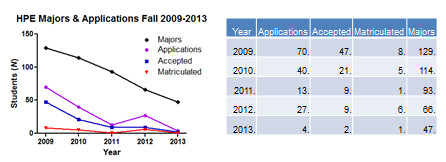
Figure 1. PETE Program Applicants and Majors
At first, the PETE faculty maintained that the declining PETE numbers were related to a broader decline in students selecting education as a major.
However, as depicted in Figure 2, the decline the PETE program enrollments was significantly greater than that observed in the College of Education.
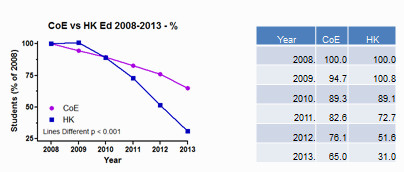
Figure 2 - Purdue PETE Enrollment Data
The data were disturbing, but again no plans were requested or initiated at that time to “quell the storm.” It wasn’t until updated figures were repeatedly
presented at subsequent departmental meetings that the real worry began to set in. Clearly, a message was being sent that our program wasn’t sustainable at
these enrollment levels and was at risk for being discontinued. Discussions of how to solve the problem were initiated through a departmental planning
group as well as our PETE faculty. A request to the college and departmental administrators to give the PETE group a two-year window to initiate a
curricular reform strategy and a recruitment effort was presented and accepted. The PETE group went to work. Beyond proposed curricular changes, the
administrators were keen on knowing what generally accepted and research driven higher education recruitment strategies would be employed to increase PETE
student enrollments.
The Proposal
After countless meetings with the PETE faculty and the singular faculty member in our health and fitness major, a proposal was submitted to our
administrators outlining a new major called the physical activity professional (PAP). This new major proposed to expand the options of students wanting to
work with youth and adults in a variety of physical activity settings including schools, youth organizations, and health clubs. The proposal provided
flexibility for those electing to pursue teaching degrees and those who wished to work in non-school settings.
Overview of the Physical Activity Professional Major
In response to the challenge to reinvigorate the PETE program, the PETE faculty developed a plan to transition to a new PAP major. In the PAP undergraduate
major, the Purdue student would develop the skills, knowledge, and dispositions needed to work with a wide variety of individuals (e.g., children, adults,
senior citizens, individuals with special needs) in a wide variety of settings (e.g., schools, health/fitness clubs, corporate settings, privately owned
businesses, Ys, community recreation centers, camps). At least half of the credits in the major would be common to all students, and these common courses
would enable students to obtain a broad base of knowledge and skills related to enhancing health and physical activity. For example, all students would
take courses such as Exercise Physiology, Psychology of Physical Activity, Motor Learning and Development, Biomechanics, Pedagogical Approaches to Teaching
Physical Activity across the Lifespan, and Program Development in Physical Activity across the Lifespan.
Beyond the common core courses, the PAP major would allow for students to specialize in a particular area by choosing from amongst several tracks. Program
tracks would be developed for those who wished to pursue teaching in schools, working in youth development settings, working in fitness-related settings,
and serving as sport coaches or instructors. The tracks would identify specific courses that best serve the career goals of the student beyond the common
core required of the PAP major. Field experiences would be an essential component of the major. Students would experience exposure to different
professional settings throughout their education, but the major would culminate in a year-long internship in a professional track. For those who wished to
be teachers, the student teaching requirement would be integrated into this year-long experience. After student teaching, a teaching major could elect to
remain in a school setting, or select another internship for the remainder of the year prior to graduation.
After developing this new direction, we requested time to turn the enrollment numbers around. We proposed two years to reverse the downward enrollment
trend through a variety of marketing strategies including improved websites, school recruitment visits, marketing brochures, and the use of various social
media. We studied websites of other programs and turned to Arizona State University’s PETE group that had previously developed recruitment materials for
their program. Our resulting marketing plan is outlined below.
Marketing Strategies for the Professional Activity Professional (PAP) Degree
It was recognized that it would be very important to employ various recruitment strategies in order to attract students to our new major. In concert with
the Office of Admissions and the College of Health and Human Science Student Recruitment Center, rigorous and sustained recruitment of students would need
to commence immediately. The strategies we selected were grounded in the work of Noel-Levitz, a major consulting firm that assists universities in the
recruitment of students. Since 1973, Noel-Levitz has partnered with faculty and department leaders in more than 2,800 campuses in the United States,
Canada, and beyond. Two-year and four-year private and public institutions have turned to Noel-Levitz for enrollment consulting, financial aid strategy,
student success planning and assessment, market research, website and e-communications consulting, and more.
A recent research report from Noel-Levitz (www.noellevitz.com/BenchmarkReports) was particularly
instructive to our proposal in terms of developing strategies for the recruitment of students into the PAP major. Table 2 overviews six recruitment
strategies that have been used by a majority of four-year academic institutions and have been found to be somewhat or very effective. We proposed to
implement all six of these strategies in our publicity efforts.
Table 2.
Recruitment strategies common among four-year institutions that have been found to be somewhat or very effective
|
Recruitment Strategies
|
Percent Usage by Four-Year Institutions
|
Somewhat or Very Effective
|
|
Campus open house events
|
95.1%
|
93.5%
|
|
Campus visit days for HS students
|
98.8%
|
96.3%
|
|
Encouraging visit on the HK, HHS, or admissions website
|
100%
|
93.8%
|
|
Off-campus group meetings for students and parents
|
82.2%
|
82.2%
|
|
H.S. visits by admissions representatives
|
98.8%
|
85%
|
|
Targeting underrepresented groups
|
91%
|
82.4%
|
In addition to these recruitment strategies, we recognized the need to employ various communication techniques that have been found to have varying degrees
of effectiveness when used by four-year institutions. Table 3 provides an overview of the strategies we selected, along with the percentage of four-year
institutions that use them and the perceived effectiveness as reported by Noel-Levitz.
Table 3.
Recruitment strategies common among four-year institutions and perceived effectiveness
|
Communication Techniques
|
Percent Usage by Four Year Institutions
|
Somewhat or Very Effective
|
|
On-line display advertising
|
72%
|
63.2%
|
|
Home page/website advertising
|
97%
|
85%
|
|
Publications – brochures
|
98.8%
|
96.3%
|
|
E-mail communication
|
100%
|
93.9%
|
|
Social Networking (e.g. Facebook)
|
93.7%
|
66.2%
|
|
Calling cell phones
|
76%
|
67%
|
We also planned to implement marketing strategies already used in both the College of Education and College Health and Human Sciences. We would present at
various events such as Purdue’s For Me, College Fairs, Experience Purdue for High School Students, and the Youth Summit at Black
Expo in Indianapolis. Furthermore, we would publish articles promoting the major in news outlets such as the Exponent, Purdue Today, and newspapers in
order to introduce this new concept to the public. Additionally, we would conduct email blasts to prospective students and produce a video that could be
placed on our website and shared across the globe via YouTube. Finally, we would employ marketing strategies on campus. For example, the PAP major would be
introduced to students enrolled in the Introduction to Kinesiology course. The curricula would be described as well as the PAP’s potential to serve others.
This message could be employed in other venues as well, such as the University’s new student orientation program.
The Outcome
Despite our best efforts, this proposal was rejected by Purdue’s administrators at the department and college levels. Ironically, no discussion or
presentation of the proposal with Health and Kinesiology faculty occurred until after the decision was announced in a faculty meeting. After statements by
various PETE faculty and other Health and Kinesiology faculty members at that meeting, the entire department faculty abstained when asked to support the
decision to eliminate the program. Nonetheless, administrative prerogative ruled and the Office of Admissions was directed to end admission into the PETE
program beginning in the fall of 2015. It was clear that administrators lacked confidence that trends could be reversed, and they were not interested in
pursuing creative curricular and program marketing solutions. It was a sad ending to a century of educating physical education teachers at Purdue.
Interestingly, given that the faculty refused to vote on the decision to close the program, it will remain on “the books” as an approved curriculum at
Purdue. However, the administrators’ decision to cease admitting students will effectively close the program at the end of the spring 2018 semester.
Resurrection of the program seems improbable, particularly with the presence of many other teacher education programs in the state and the prioritization
of other curricula in the HK department.
Closing comments
Sadly, this appears to be the end of the golden area for PETE at Purdue University. Unfortunately, we believe that our experience is not all that uncommon.
Programs across the country are at risk, and trends indicate that this seems to be particularly true of those housed in research-intensive institutions.
Ironically, this is occurring at a time when the need for the preparation of physical education and physical activity professionals has never been greater.
The dreadful data relative to health risks bear this out. While there is a noted need for children to learn how to lead healthy lifestyles, state
governments and local school districts do not seem to view physical education as the means of addressing this need. The “No Child Left Behind” era along
with declining funds have resulted in schools emphasizing math, science, and reading, to the decline of physical education. More and more school districts
are requiring less and less physical education, so the demand for physical education teachers has declined. In turn, this decline may provide justification
for PETE program elimination. In addition, the unwillingness of state and federal governments to mandate daily physical education and to elevate the status
of the subject communicates that physical activity instruction is increasingly being seen as a non-school issue. The assumption appears to be that
community-based entities and families will take responsibility for physical skill development and fitness.
Nevertheless, for the time being, many school districts still employ physical education specialists, which makes college/university PETE program
elimination somewhat paradoxical. So, while the research-intensive institutions may continue to drop their programs, we believe smaller institutions will
continue to offer PETE programming. However, this gives rise to two additional questions. If the elimination of research-intensive institutions continues,
1) where will the doctoral education of PETE faculty occur, and 2) who will conduct research aimed at the advancement of the physical education profession?
While some smaller institutions fulfill both of these roles, these are responsibilities that have traditionally fallen to the research-intensive
institutions such as Purdue University, that have eliminated or will eliminate their programs.
While the reasons for program elimination are numerous, one potential cause is related to the precarious academic homes occupied by many PETE programs.
Historically, all programs were in departments of physical education, which grew house sub-disciplines such as exercise science, motor control and
development, and exercise psychology. However, over time many of these departments have evolved into departments of kinesiology and health. While PETE
programs are often still housed in these departments, many other education majors are sited in colleges of education. This is the case at Purdue
University. One can only speculate, but would the PETE program have been eliminated if, sometime ago, it had separated from the Department of Health and
Kinesiology (and the College of Health and Human Science and previously the College of Liberal Arts) and became a specialization within the College of
Education? In many kinesiology and health departments physical education has become marginalized. While this marginalization may also occur in colleges of
education, at least all of the academic programs would share some key commonalities related to a focus on preparing future teachers. College of education
administrations may also be more understanding of declining and fluctuating enrollment numbers given that to some extent, they are seen across education
majors. Further, physical education would stand alongside other traditionally marginalized school subjects, such as art and music education, which would
allow for increased communication and coordination than is possible when physical education resides in a completely different college.
So if you are concerned about the livelihood of your program, what should you consider and what might you do? While there are no guarantees, we suggest you
consider the following:
• The vulnerability of PETE links to changing priorities, especially by those who wish to emphasize the disciplines within kinesiology that have less of or
no professional or clinical elements.
• Enrollment drives program sustainability and programs need to analyze enrollment trends and be prepared to conduct regular marketing strategies to
maintain or increase enrollment levels.
• Become familiar with and use entities/resources within your institution that can assist with enrollment.
• PETE programs of the past may not be attractive or sustainable. Providing curricular and professional options within a physical activity context appears
to be commonsensical. This will require some thinking outside the box in order to provide these options while still following college and accreditation
requirements.
• Regular communication of program activities and successes is important to internal and external stakeholders, and especially to prospective students and
their families.
• Use of social media to tell your story of success is as important as is face-to-face visits with prospective students.
• Advocate regularly for the work done by your PETE program in the college, university, and community. Let others know about the importance of physical
education and quality PETE programming, and then demonstrate to others how your program achieves this standard of quality.
• Develop outreach and service programs that embed PETE students and faculty within the community where they can use their skills and expertise in service
to others. Then, communicate the importance of these programs on campus.
• Educate non-PETE departmental and college administrators on the importance of high quality physical education and the needs filled by the PETE program.
• Partner with communities entities, such as local school districts and Ys, to provide continuing professional development opportunities through in-service
training.
• Attract external funding for various elements of your program (research projects and outreach into the community) that is of a magnitude that reinforces
the value of PETE faculty and their programs.
In the end, the Purdue PETE faculty members, those students within the program, and our graduates–undergraduate and graduate students alike – are saddened
by the impending closure of a program that has achieved so much. It is the end of a golden era for us, and we can only hope that other PETE faculty members
will hear our exhortation to stay on top of program promotion and student recruitment. Failure to do so may result in the demise of their programs as well.
Biographies:
Thomas Templin
is a well-known author, editor, and reviewer of numerous physical education publications. He is a former President of the National Association for Sport
and Physical Education (NASPE) and has received various honors through his career including the 2014 McCloy Lecturer from AAHPERD and the 2012 Scholar
Award from the Special Interest Group on Learning and Instruction in Physical Education within the American Educational Research Association (AERA). He was
recently inducted into Purdue University’s Book of Great Teachers.
Bonnie Tjeerdsma Blankenship
is a professor and undergraduate program director in the Department of Health & Kinesiology at Purdue University. She has published two books and
numerous journal articles. She is a former editor of the Journal of Teaching in Physical Education and former NASPE board member. Blankenship
currently serves as co-director the Purdue Athletes Life Success program, a free summer day camp for underserved youth in the Greater Lafayette community.
K. Andrew R. Richards
is a visiting assistant professor at Northern Illinois University in DeKalb, IL. Richards completed his Bachelor’s Degree at Springfield College (MA) and
subsequently his Master’s Degree and Ph.D. at Purdue University. After completing his Ph.D., Richards served as a post-doctoral research associate in the
Center for Instructional Excellence at Purdue University. His research focuses the socialization of physical education teachers with an emphasis on role
stress, burnout, and resilience. He is also interested in innovative approaches to teaching and service-learning pedagogies in higher education.
(back
to pelinks4u homepage) |




